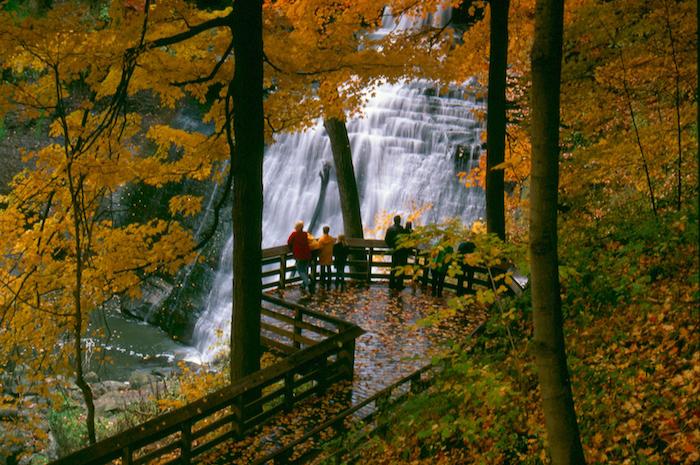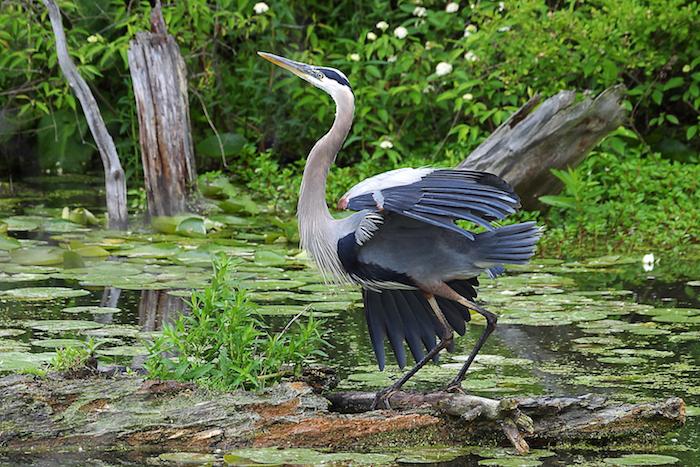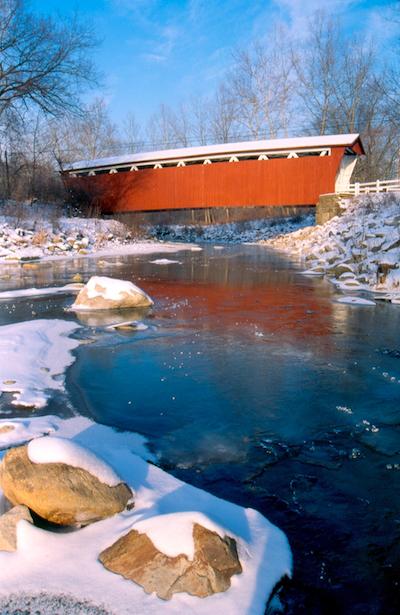
Brandywine Falls is a main attraction at Cuyahoga Valley National Park/Photo by Tom Jones
Surrounded by thickly settled areas, and crisscrossed by interstate highways, Cuyahoga Valley National Park in Ohio nevertheless manages to provide a sanctuary of nature that can be a salve for the soul for those trying to find a break from today's hectic world.
Leave the rock 'n roll to Cleveland, and the fast food industry history to Columbus (where the first Wendy's opened back in 1969. Come to Cuyahoga Valley to spy bald eagles raising their young, beavers at work, or river otters frolicking as only river otters can do. Or take a hike on the more than 100 miles of trails, pedal your way along the Ohio & Erie Canal Towpath Trail (or along some of the other 20 miles of biking trails), paddle one of the waterways (by canoe or kayak), or saddle up to explore one of the bridle trails that weave through the greenery.
You could even test your drive on one of the four golf courses within the park, or try your skills of deduction on the park's "Questing" course, in which you "follow rhyming clues and a curious map to each hidden quest box. Along the way, discover the area's treasures—the natural and cultural gems of the Canalway."
Yes, Cuyahoga Valley is unlike most national parks in the system. But it offers a wide range of activities for its surrounding urbanized areas and their residents. Winter brings opportunities for skiing (alpine and nordic) and snowshoeing, ice fishing, and even sledding.
The base camp for winter exploration in the park is the Winter Sports Center at Kendall Lake Shelter, an impressive sandstone and chestnut structure constructed by the Civilian Conservation Corps in the 1930s. Here you can get information on trail conditions and warm up with a hot drink.
Practically all of the park’s 125-plus miles of hiking trails are open to snowshoeing. There are about 50 miles of trails and meadows for cross-country skiers, and the Ohio & Erie Canal Towpath has 20 miles of trails for skiers.

Beavers, otters, ducks, and even great blue herons reside in Cuyahoga Valley National Park/NPS
Spring, as in most other parks, is a season of renewal, which could bring you within view of the park's nesting bald eagles. Summer is the season for hikes, either by yourself, friends and family, or perhaps a ranger. Check the park's calendar of events to see what opportunities there might be when you intend to vist Cuyahoga Valley.
Fall brings additional opportunities for wildlife viewing. Head out around sunrise looking for beavers in the park’s wetlands and along the Cuyahoga River, and also watch for river otters. Try the appropriately named Beaver Marsh. The elevated boardwalk there serves as a great viewing platform. And keep a lookout for migrating birds, especially in November.
Fall also is a great time to board the Cuyahoga Valley Scenic Railroad to take in the seasonal colors in comfort. According to the National Park Service, "(T)he history of trains in the Cuyahoga Valley stretches back more than 100 years. In 1880, the Valley Railway began operations, transporting coal to Cleveland, Akron, and Canton from the Tuscarawas River Valley and providing passenger service along the way. It became another way to escape the pressures of urban industrial life."
And in winter, the train offers special Polar Express excursions.

The Everett Covered Bridge attracts many cameras/NPS
Not to be overlooked is the cultural side of Cuyahoga Valley. While humans have roamed the landscape for an estimated 12,000 years or more, more recent history that lures visitors are places like the Boston Store, which was built along the Ohio & Erie Canal back in 1836, or the 65-foot Brandywine Falls, or the Canal Exploration Center that tracks the history of the Ohio & Erie Canal and also serves as a visitor center.
While there is much to photograph in the park, the Everett Covered Bridge attracts many cameras in winter when snow shimmers against the red-painted covered bridge.
Looking for a place to stay in the park? Check into the Inn at Brandywine Falls, a renovated pre-Civil War farmhouse that offers four guest rooms in the farmhouse and two loft suites in an accompanying carriage house.
In assessing the park, David and Kay Scott, Traveler contributors and authors of The Complete Guide to the National Park Lodges, had this to say:
Cuyahoga Valley National Park interprets the rich history and helps preserve the landscape along 22 miles of the U-shaped Cuyahoga River as it flows between Cleveland and Akron. The 33,000-acre park was created by Congress in 1974 as a national recreation area, with the designation changed in 2000 to national park. It appears the change in designation was primarily political because the park retains the qualities of similar urban units such as Golden Gate National Recreation Area clustered around San Francisco and Gateway National Recreation Area in the New York-New Jersey metropolitan area, rather than most of our national parks. This isn’t to belittle the park, because it is a genuine treasure, especially for people who live in the area.



Add comment